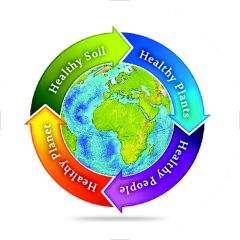Sewage sludge is quickly becoming one of the main inputs used in soils & composts, even those used on farmlands & gardens.
Sewage sludge, aka Biosolids, is a product of wastewater treatment.
These separated processed solids – sewage sludge – contain numerous known and unknown hazardous materials. This includes everything that is flushed into the sewer system, including: household, medical, chemical, and industrial waste; chemicals and metals that leach from the sewer pipes themselves; and novel materials that are created in the wastewater treatment plant as a result of the combination of chemicals and organic compounds present.
That’s right – these Biosolids, often full of toxic compounds, nanomaterials, hormones, and dangerous pathogens, are applied to the very food we eat. While certain sanitation processes do decrease some health risks, chemicals such as PCBs, flame retardants, heavy metals, and endocrine disrupters – many of which are carcinogens – are not filtered out. Instead, they accumulate in the soil and are taken up by crops, putting human health at risk.
Worse, companies don’t have to disclose when sewage sludge is used in their compost and soil products.
Still worse, these companies can, and often do market those products as “organic”.
Why?
1. Soils and composts are excluded from the USDA’s strict regulations on the use of the term “organic”.
2. These companies use the chemical definition of the term “organic” – simply meaning containing carbon.
The corporatization of agriculture means that fewer and fewer people (acting through corporations) are controlling more and more of our food production. One of the symptoms of this corporate takeover is the land application of sewage sludge on croplands.
The EPA and big Agri-Corporations claims it is safe because toxic pollutants are limited, yet, three pollutant limits are still above safe landfill boundary levels.
Not only that, but EPA only directly addresses 8 out of 126 priority toxic pollutants in Class A “Exceptional Quality” sludge fertilizer, which have all been identified to cause death, disease, cancer, etc., either by direct exposure or indirect exposure through the food chain.
Safe?
The EPA is now actively & aggressively pushing the Biodigester industry.
Here in Vermont, with the enactment of the new Universal Recycling Act (Act 148), grants are being used to support this industry.
Vermont’s Universal Recycling Act (Act 148) even states that it seeks to promote the use of sewage sludge as a beneficial amendment, stating:
(2) its value as a soil amendment (p. 12).
And:
(8) actions which can be taken through existing state programs to
facilitate beneficial use of septage and sludge (p. 13).
One of the biggest problems to arise from this ill-conceived legislation will be the convoluted nature of the true contents of composts and soils.
• Most sewage sludge is now sent to specialty third-party processors, to be included & used in Biodegesters.
• These third-party processors will mix together any number of wastes, including vegetative, animal manures, and sewage sludge.
• The resultant end-product, anaerobically digested wastes, which becomes unrecognizable, is then sent to soil & compost facilities and companies, whom then mix that product with other products, like ground forest products, and bag them.
Thus many compost companies and facilities don’t even know what all is in the input materials they receive from these third-party processors.
Their products are also then mostly sent to & sold by retailers, whom remain completely ignorant of the true contents of those soils & composts.
Out of sight, out of mind?
Ignorance is bliss?
Plausible deniability?
For further reading:
